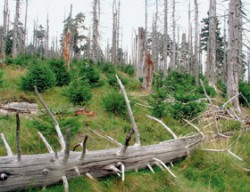Přímý dopad SO2 na horské lesy způsobující velkoplošné úhyny se začal snižovat v 90. letech 20. stol. po odsíření hlavních zdrojů SO2. Dlouhodobá půdní acidifikace (okyselení) a nízký poměr bazických iontů (Ca, Mg, K) vůči hliníků v půdě negativně ovlivňují lesy i nadále. I přes prokazatelné snížení atmosférické depozice síry se chronicky projevuje nízká saturace bazickými ionty, hlavně pak v porostech intenzivně lesnicky obhospodařovaných smrkových monokulturách. K tomu přistupuje další hrozba, a to saturace již tak degradovaných půd dusíkem.
In the Czech Republic the direct effect of SO2 on the mountain forests decreased during the 1990s as a result of the desulfurization of large SO2 sources. Chronic soil acidification, nutrient base cations (Ca, Mg, K) depletion and aluminum mobilization has been the most important mechanism behind forest damage since the 1990s. Despite a significant decline in atmospheric deposition, its present level together with high uptake of base cations by Norway Spruce monocultures will not allow significant soil recovery during the next few decades. In addition, critical loads for nutrient nitrogen have been significantly exceeded in mountain forests.
 Okyselení půd bylo hlavní příčinou úhynu lesů ve vrcholové části Jizerských hor. Foto L. Dostál / © Foto L. Dostál
Okyselení půd bylo hlavní příčinou úhynu lesů ve vrcholové části Jizerských hor. Foto L. Dostál / © Foto L. Dostál




